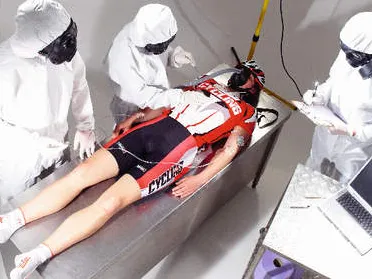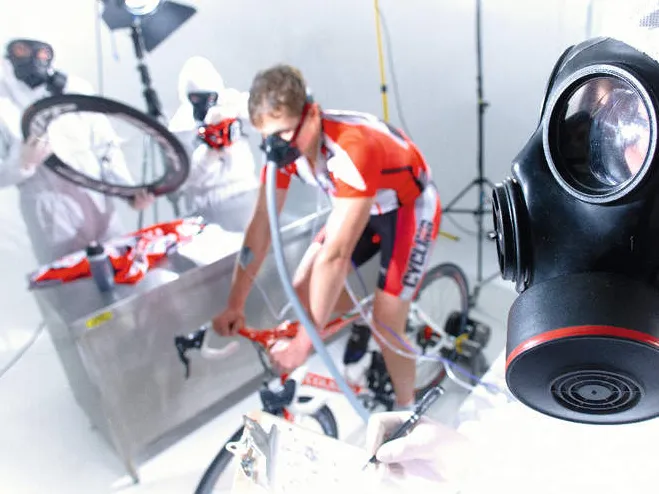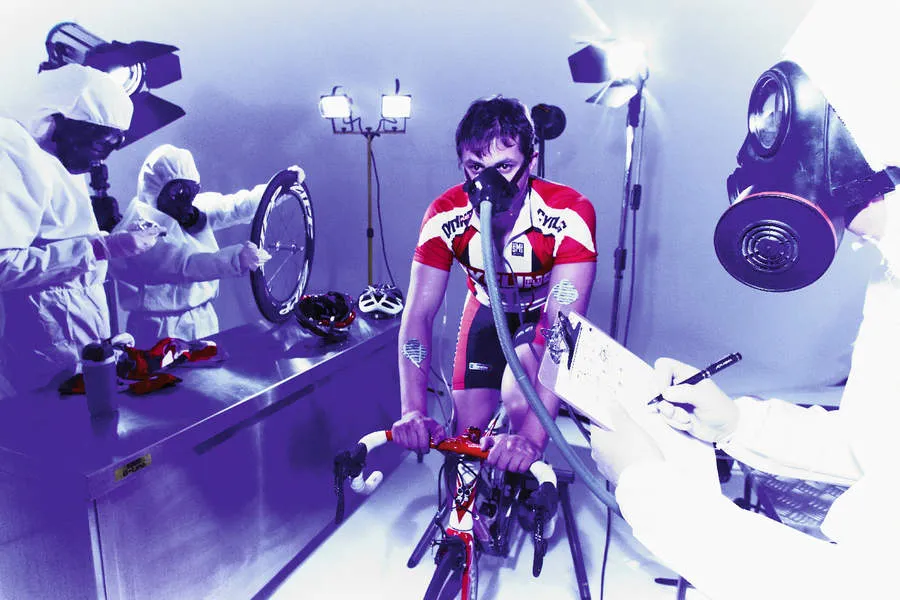Cycling is unusual in athletic sports for the amount of information that's available in real time. Speed, heart rate, power, cadence and more can all be flashed up on screen in front of the rider out on the road.
Used properly, all this data can take some of the guesswork out out of training and allow direct comparison of physiological states between one session and the next.
Here's a guide to finding out the most important measures of your cycling performance, and what to do with them.
POWER OUTPUT
What are we measuring?
Strictly speaking, we don’t measure power – we measure torque and we measure time. Power is torque over time. Torque is a measurement of work done. Power is a measurement of how quickly you can do that work. So two identical cyclists on identical bikes climbing the same hill do the same amount of work. The one who does it quickest is making the most power. Don’t forget you can make the same overall power by pushing hard in a high gear, or pedalling more softly but at a higher cadence in a smaller gear.
How do we measure it?
With a bike-based power meter or a turbo trainer/gym bike with power readout.
What does it tell us?
It’s a pitiless observer of exactly what your body’s doing. Speed is related to environmental conditions, and heart rate can be unreliable, unstable and hard to analyse on the fly, but power is a direct measure of the work you’re doing and the rate you’re doing it at. That means you can assess your weak spots and target them. It also means you can work on your efficiency as well as your brute strength – trying out different pedalling styles, riding positions and cadences at the same power output to see which suits you best.
HEART RATE
What are we measuring?
At its simplest, a one-off snapshot of your heart rate in one steady state – whether resting or working hard. At its most complex, a full-on lab-based ECG test. For most of us, a real-time readout of how fast your heart is pumping.
How do we measure it?
The easiest thing you can measure is your resting heart rate. It’s the cheapest way too; you don’t need a heart rate monitor – you don’t even need to get out of bed! The idea is to take your own pulse as soon as you wake up in the morning, when you’re as relaxed as possible. Lay back, relax, breathe deeply but gently, find your pulse (on the left side of your neck, under the corner of your jawbone is usually easiest), and count it for 30 seconds. Multiply by two and you have your resting heart rate.
Maximum heart rate is a bit different. Everyone knows the theory – 220 minus your age equals your theoretical max heart rate. Simple, easy to understand and apply – a lot of heart rate monitors even do it automatically. Sadly, it’s also complete rubbish. Some people are naturally high beaters, and if you just apply the ‘rule’ you could end up with a completely false sense of what level you’re working at.
So you need to find your true max rate. This is most commonly done via a lab-based ramp test: a warm-up followed by a gradually increasing workload, until the point you can no longer maintain the effort and have to back down. The highest recorded heart rate is your maximum.
What does it tell us?
Resting rate is extremely useful. It shouldn’t really vary that much from day to day, and if it does, it’s time to ask why. If it’s raised by more than 10bpm for no apparent reason (hangover, interrupted sleep…), it’s a fair bet there’s something wrong – maybe you’ve been overtraining, or you’re fighting off a bug. Either way, you should knock back the intensity of your training to suit.
As a rule, the more highly trained you are, the lower your resting heart rate is likely to be because your heart pumps more blood per beat, so at rest it’s barely ticking over. Average for an untrained male would be around 75bpm, whereas a fit club cyclist could expect to be in the high 40s or low 50s.
Maximum heart rate is useful to calculate training zones, which most coaches base on the work of acclaimed British Cycling coach Peter Keen from the Eighties onwards. So anything under 50 beats below your maximum is classed as a gentle recovery session; 30-50 below max is endurance training; 15-30 beats below is intensive training, and 0-15 beats below is classed as anaerobic, unsustainable for anything longer than a few minutes.
The zones are often expressed as percentages, and many coaches split them up further into six or seven narrower zones, but the principle remains. The trouble with heart rate is that it has a built-in lag compared to the work you’re doing – that makes it hard to use for short interval sessions of the kind favoured for improving VO2 max, because by the time your heart rate rises to the level prescribed, you’ve already been working at that threshold for minutes.

CADENCE
What are we measuring?
The number of times you turn the pedals a complete revolution every minute.
How do we measure it?
You can just count the pedal strokes on one leg for 15 seconds and multiply by four. Otherwise you need a cadence-specific bike computer with a sensor, usually on the left chainstay, triggered by a magnet on the back of the left crank.
What does it tell us?
Cadence is an integral part of many power measurement systems. It’s also good to establish where your most efficient and comfortable cadence lies – for most people it’ll be somewhere between 80-100rpm – so you can use your gears to keep you there as much as possible. That said, it’s also useful to teach yourself to be flexible enough to accelerate a big gear from well below your normal cadence, and spin it to well beyond – vital for a sprinter, for example, who might need to go from 40-140rpm in one gear to avoid wasting time changing gear during the sprint.
Cadence can also be useful for high intensity hill or speed intervals – aiming to attack a hill, for example, at a pace slightly higher than you can sustain. Once you can’t sustain your cadence and it drops by, say 5%, the interval’s over.

LACTATE LEVELS
What are we measuring?
The proportion of lactic acid in your bloodstream at any one time. Lactic acid is a by-product of muscle activity, created as sugars are broken down with oxygen to fuel the muscles.
How do we measure it?
As part of a lab-based ramp or Conconi test. Blood samples are taken before, during and after the test, and analysed using a special meter to provide a comparison. The result is expressed in millimoles per litre of blood. A millimole is a chemical measure, but all you need to know is that in this case, when your legs start really hurting, the value’s gone too high.
What does it tell us?
Plenty, and it’s vital information. We’re looking for the maximum level of work you can sustain before your muscles can no longer clear the lactic acid away fast enough to keep up. Stay under this threshold (generally accepted to be about 4 millimoles/litre) and you can pedal at that intensity all day, as long as you keep yourself fed and watered. Go above it and the accumulation of acid in the muscle gives you that heavy, burning feeling, and you have to knock back the effort a long way before you start to recover.
More importantly, it’s not a gradual process – think of staying under the threshold as a long gentle rise, and going over it as unexpectedly as hitting the steepest bit of Alpe d’Huez. In the big ring. Lactate threshold and VO2 max are closely related (in an untrained cyclist, LT could be 60% of VO2 max, for a top pro up to 85-90%) but respond to different targeted training – if you know your lactate threshold you can train specifically to improve it.

AEROBIC CAPACITY
What are we measuring?
Several things: Forced Expiratory Volume (FEV) is the maximum capacity of your lungs. As a refinement of this, we also measure FEV1, which is the volume exhaled in the first second of the test. The relationship between the two is expressed as a percentage: FEV1/FEV. There’s also Peak Expiratory Flow (PEF), which is the maximum rate at which air is expelled, regardless of duration. Those are measures of lung function and capacity, but VO2 max is more important because it measures efficiency – the body’s ability to take in air, extract oxygen from that air and deliver it to where it’s needed.
How do we measure it?
FEV, FEV1 and PEF are measured with a simple handheld flow meter – it can be a simple calibrated extending tube or an electronic device. You fill your lungs as much as you can, then empty them as hard and completely as possible, to the point where you really can’t get any more out and would faint if you didn’t breathe in.
What does it tell us?
Obviously, outright lung capacity is important. Your lungs are a pump, powered by muscle. Their first job is to pump as much air as possible in and out. That’s governed by lung volume and muscular efficiency, and having a big pump is a great start for any endurance athlete. But on its own it’s not very useful – VO2 max is more important. You’ll need to keep an eye on FEV and PEF if you suffer from asthma, though, as it’s a way of keeping tabs on the condition, and a falling capacity over a day or so can be an early warning of an attack.
VO2 max is much more interesting. It’s no good breathing loads of air if you’re not extracting the maximum use from it while it’s in there, and that means getting the oxygen from the air into your bloodstream and your muscles as efficiently as possible. Your lung capacity test will tell you how much air you can take in, but you need to know how much of it you can use; VO2 max is a measure of that.
Of course, you can try to get access to a lab with full breathing equipment and a gas analyser to get a proper medical result. Or you can do what most people do and use a ramp test to come up with something more useful – a sustained power or heart rate figure that relates to the level at which you exceed your VO2 max threshold. Even better, you don’t need any complicated equipment to do the test, though it’s easier if you have a turbo trainer as you can just plod along in your garage, without being interrupted by traffic.
Unlike most other performance indicators, your VO2 max potential isn’t directly related to how well trained you are. There’s a huge hereditary/genetic influence, and although you can improve your VO2 max levels with training, ultimately you’ll be limited by your physiology – in the same way that you can make your legs stronger, but you can’t make them longer. At extremes, if you’re starting from a fairly low level, then no matter how hard you train you might still find an untrained beginner with the ‘right’ genetic makeup already has you beaten. But don’t despair. You may not be able to improve your outright VO2 max itself, but knowing the limit means you can plan your training sessions, which will increase the amount of time you can spend just below the threshold.

ANAEROBIC CAPACITY
What are we measuring?
Your flat-out capacity over and above the point where the heart and lungs can keep the muscles supplied with oxygen. This divides into several parts: Absolute Peak Power does what it says on the tin – it’s the highest power figure (in Watts) you produce. But it’s less important than Relative Peak Power, which is that figure related to your weight and expressed in Watts/kg. Anaerobic Fatigue is the difference between your peak effort and the reading at the end of the test, expressed as a percentage.
How do we measure it?
With a Wingate test in the lab. Developed in the Seventies in Israel, it’s almost always conducted as a cycling test regardless of the athlete’s actual sport. The test itself is just 30 seconds long.
What does it tell us?
It’s a useful measure of your ability to make a short, intense effort, whether that means bridging a small gap, sprinting back up to speed out of corners, or putting everything you have into a flat-out sprint at the end of the race. More interestingly, the power trace over the 30 seconds of the test shows graphically exactly the point where three separate power systems take over from each other.
Once you’ve gone beyond the point where your heart and lungs can happily keep up with demand, you have a brief high-power reserve of Adenosine Triphosphate, which will keep your muscles working at peak capacity for a few seconds at most. Once that’s gone, the muscles start on another reserve, this time of a compound called Phosphate Creatine. This lasts a lot longer – up to 20 seconds if you’re really lucky. Once that’s gone, you’re really in trouble – the muscle starts to get the munchies and scoff its reserves of glucose, but because there’s no oxygen getting to the muscle to burn it with, you get a catastrophic and immediate build-up of lactic acid, and you slow down and stop, whether you want to or not.
Your anaerobic capacity is a precious reserve, but because once it’s gone, it’s gone, you need to learn not only how and when to use it, but when NOT to use it. Regular tests will help you gauge your progress, but they’ll also help you to learn how to manage your reserves. ...
HAEMATOCRIT
What are we measuring?
The ratio of red blood cells to white cells and plasma – the more red cells, the higher the Haematocrit (HC) value. Red cells are the blood’s oxygen carriers, so along with lung capacity and VO2 max, this determines how efficiently you can turn a lungful of air into oxygen that’s available to your muscles as they need it.
How do we measure it?
Until now you’ve needed either a proper lab, or a portable system that uses a centrifuge to separate the blood into its component parts. Smaller, cheaper systems are now coming onto the market, but they’re still too expensive to be viable for individuals.
What does it tell us?
For you and me, not a lot. It’ll be an interesting number but not something you can do much about – it’s not something that responds to training as such, which is a blow if your HC turns out to be naturally very low. What it does respond to remarkably well is cheating, specifically a course of EPO – which is one reason why pros’ HC levels are so closely monitored as part of continuous drugs testing (and why in the bad old days every team’s doctor had a testing kit on hand). A test level of more than 50% is deemed to be dangerous as the blood’s getting too thick and there’s a danger of heart attack while resting, but it’s also an indication of potential EPO use as very few people have a natural HC level above 50% – over 95% of people are naturally down around the low 40s.
